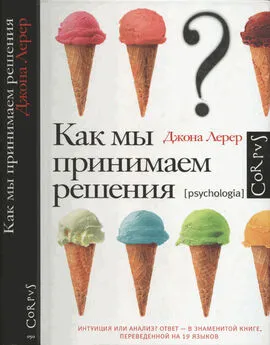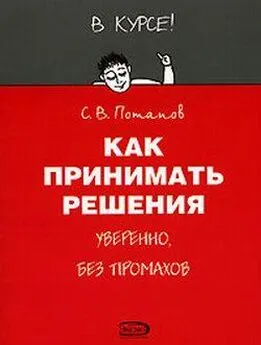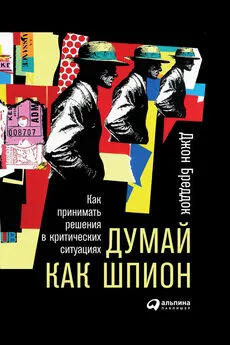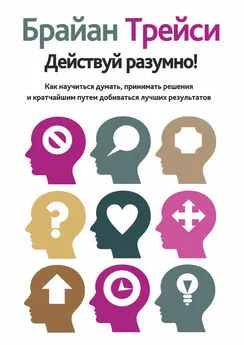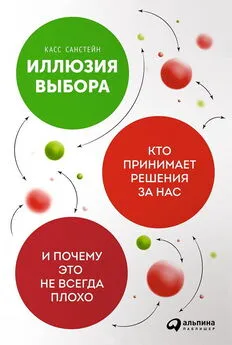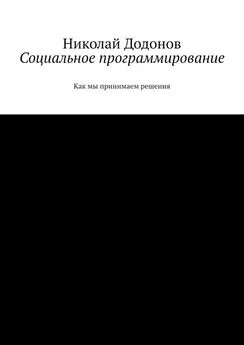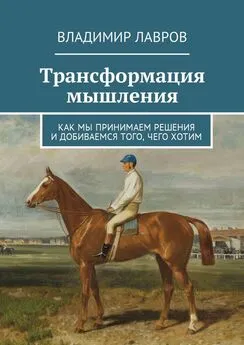Джона Лерер - Как мы принимаем решения
- Название:Как мы принимаем решения
- Автор:
- Жанр:
- Издательство:ООО “Издательство Астрель” CORPUS
- Год:2011
- Город:Москва
- ISBN:978-5-271-26397-2
- Рейтинг:
- Избранное:Добавить в избранное
-
Отзывы:
-
Ваша оценка:
Джона Лерер - Как мы принимаем решения краткое содержание
Каждое мгновение мы принимаем решения: от очень важных до малозначимых и повседневных. Именно это свойство — умение делать свободный выбор — и делает человека человеком. Но как это происходит? Как работает мозг, в доли секунды обрабатывающий колоссальный объем информации? Как соотносятся разум и интуиция? Эти вопросы занимают не только философов и нейрофизиологов, но и каждого из нас.
Джона Лерер, американский журналист и всемирно известный популяризатор науки, не только увлекательно описывает, как устроен механизм принятия решений. Книга «Как мы принимаем решения» рассказывает и о том, как происходит процесс выбора, и одновременно помогает сделать этот процесс эффективнее.
Как мы принимаем решения - читать онлайн бесплатно полную версию (весь текст целиком)
Интервал:
Закладка:
Chugani, H., Michael Behen, Otto Muzik, CsabaJuHasz, Ferenc Nagy, and Diane C. Chugani. Local Bram Functional Activity Following Early Deprivation: A Study of Postinstitutionahzed Romanian Orphans. Neuroimage14 (2001): 1290–1301.
Cimpian, Andrei, Holly-Marie Arce, Ellen Markman, and Carl Dweck. Subtle Linguistic Cues Affect Children’s Motivation. Psychological Science 18 (2007): 314—16.
Cohen, Jonathan. The Vulcanization of the Human Bram: A Neural Perspective on Interactions between Cognition and Emotion. Journal of Economic Perspectives 19 (2005): 3—24.
Cohen, Jonathan, Todd Braver, and Joshua Brown. Computational Perspectives on Dopamine Function in Prefrontal Cortex. Current Opinion in Neurobiology 12 (2002): 223—29.
Cohen, Michael, et al. Reinforcement Learning Signals Predict Future Decisions. Journal of Neuroscience27 (2007): 371—78.
Colom, Roberto, Carmen Flores-Mendoza, M. Angeles Quiroga, and Jesus Privado. Working Memory Is (Almost) Perfectly Predicted by G. Intelligence32 (2004): 277—96.
Cooper, Marc. Sit and Spin. Atlantic Monthly, December 2005. Damasio, Antonio. Descartes’ Error. New York: Penguin, 1995.
Damasio, Antonio, et al. Subcortical and Cortical Bram Activity during the Feeling of Self-generated Emotions. Nature Neuroscience 3 (2000): 1049—56. Dapretto,М., et al. Understanding Emotions m Others: Mirror Neuron Dysfunction in Children with Autism Spectrum Disorders. Nature Neuroscience 9 (2006): 28–31.
Darwin, Charles. The Expression of the Emotions m Man and Animals. New York: Oxford University Press, 1998. First published in London by John Murray, 1872.
Davidson, Janet, and Robert Sternberg, eds. The Psychology of Problem Solving. New York: Cambridge University Press, 2003.
Dayan, Peter, and L. F. Abbot. Theoretical Neuroscience. Cambridge:MIT Press,2001.
Dayan, Peter,S. Kakade, and PR. Montague. Learning and Selective Attention. Nature Neuroscience 3 (2000): 1218—23.
Deeley, Quinton, et al. Facial Emotion Processing m Criminal Psychopathy. British Journal of Psychiatry189 (2006): 533—39. de Martino, Benedetto, Dharshan Kumaran, Ben Seymour, and Raymond J. Dolan. Frames, Biases and Rational Decision-Making m the Human Bram. Science313 (2006): 684—87.
Deyo, Richard, A. Nachemson, and S. K. Mirza. Spmal-Fusion Surgery: The Case for Restraint. New England Journal of Medicine 350
(2004): 722—26.
Dijksterhuis,Ap. Breakthrough Ideas . Harvard Business Review, February
2007.
Dijksterhuis, Ap, Rick B. van Baaren, Karin C. A. Bongers, Maarten Bos, Matthijs L. van Leeuwen, and Andries van der Leij. The Rational Unconscious: Conscious Thought versus Unconscious Thought m Complex Consumer Choice. Working paper.
Dijksterhuis, Ap, Maarten Bos, Loran Nordgren, and Rick van Baaren. On Making the Right Choice: The Dehberation-Without-Attention Effect. Science 311 (2006): 1005—07.
Dijksterhuis, Ap, and Ad van Knippenberg. The Relation Between Perception and Behavior, or How to Win a Game of Trivial Pursuit. Journal of Personality and Social Psychology 74 (1998): 865—77.
Dijksterhuis, Ap, and Loran Nordgren. A Theory of Unconscious Thought. Working paper.
Dijksterhuis, Ap, and Zeger van Olden. On the Benefits of Thinking Unconsciously: Unconscious Thought Can Increase Post-Choice Satisfaction. Journal of Experimental Social Psychology 42 (2006): 627—31.
Dolan, Ray, et al. Dopaminergic Modulation of Impaired Cognitive Activation in the Anterior Cingulate in Schizophrenia. Nature 378 (1995): 180—82.
Dougherty, Pete, and Jim Wyatt. Will Wonderlic Scores Cause Teams to Wonder about Young f USA Today, March 1, 2006.
Dweck, Carol. Mindset. New York: Random House, 2006. Self-Theories. Philadelphia: Psychology Press, 2000.
Ekman, Paul. An Argument for Basic Emotions. Cognition and Emotion 6 (1992): 169–200.
El-Hai, Jack. The Lobotomist. New York:Wiley, 2007.
Fama, Eugene. Random Walks in Stock Market Prices. Financial Analysts Journal, September/October 1965 (reprinted January/February 1995).
Fehr, Ernst, and Klaus Schmidt. A Theory of Fairness, Competition, and Cooperation. Quarterly Journal of Economics 71 (1999): 397–404. Finlan, Alastair. The Royal Navy m the Falklands Conflict and the Gulf War. London: Routledge, 2004.
Fleck, Jessica, and Robert Weisberg. The Use of Verbal Protocols as Data: An Analysis of Insight in the Candle Problem. Memory and Cognition 32 (2004): 990—1006.
Fleming, Renee. The Inner Voice. New York: Viking, 2004.
Frank, Robert. Passions Within Reason. New York:Norton, 1988.
Freud, Sigmund. Civilization and Its Discontents. New York: Norton, 2005. New Introductory Lectures on Psychoanalysis. London: Hogarth Press, 1933. Gailliot,М. Т., R. Baumeister, C. N. DeWall, J.K. Maner, E. A. Plant, D.M. Tice, L. E. Brewer, and B. J. Schmeichel. Self-Control Relies on Glucose as a Limited Energy Source: Willpower Is More Than a Metaphor. Journal of Personality and Social Psychology 92 (2007): 325—36. Galvan, Adriana, Todd A. Hare, Cindy E. Parra, Jackie Penn, Henning Voss, Gary Glover, and B. J. Casey. Earlier Development of the Accumbens Relative to Orbitofrontal Cortex Might Underlie Risk-Taking Behavior in Adolescents. Journal of Neuroscience 25 (2006): 6885—92. Gaspar, P., ЕТ al. Catecholamine Innervation of the Human Cerebral Cortex as Revealed by Comparative Immunohistochemistry of Tyrosine Hydroxylase and Dopamine-?-hydroxylase. Journal of Comparative Neurology 279(198): 249—71.
Gazzaniga, Michael. The Social Brain. New York: Basic Books, 1985. Gazzaniga, Michael, ed. The New Cognitive Neurosciences. Cambridge: MIT Press, 2006.
Geier, Andrew, Paul Rozin, and Gheorghe Doros. Unit Bias: A New Heuristic that Helps Explain the Effect of Portion Size on Food Intake. Psychological Science 17 (2006): 521—27.
George, Carol, and Mary Main. Social Interactions of Young Abused Children. Child Development 50 (June 1979): 306—18.
Gigerenzer, Gerd. Gut Feelings. New York: Viking, 2007.
Gigerenzer, Gerd, and Reinhard Selten, eds. Bounded Rationality: The Adaptive Toolbox. Cambridge: MIT Press, 2000.
Gilbert, Daniel. Stumbling on Happiness. New York: Knopf, 2007. Gilovich, Thomas. How We Know What Isn't So: The Fallibility of Human Reason in Everyday Life. New York: Free Press, 1991.
Gilovich, Thomas, Robert Vallone, and Amos Tversky. The Hot Hand in Basketball: On the Misperception of Random Sequences. Cognitive Psychology 17 (1985): 295–314.
Gladwell, Malcolm. Blink. Boston: Little, Brown and Company, 2005. The Art of Failure. The New Yorker, August 21, 2000.
Glimcher, Paul. Decisions, Decisions, Decisions: Choosing a Biological Science of Choice. Neuron 36 (2002): 323—32. Decisions, Uncertainty, and the Brain. Cambridge: MIT Press, 2003.
[RTF bookmark start: s][RTF bookmark end: s] Glimcher, Paul, and Aldo Rustichini. Neuroeconomics: The Consilience of Bram and Decision. Science 306 (2004): 447—52.
Goodwin, Doris Kearns. Team of Rivals. New York: Simon and Schuster, 2005.
Gordon, Dan, ed. Your Bram on Cubs. New York: Dana Press, 2007. Graden, Brian. Interviewed on The Merchants of Cool, Frontline, PBS, February 26, 2001; http://www.pbs.org/wgbh/pages/frontline/shows/cool/interviews/graden.html.
Green, Donald, Bradley Palmquist, and Eric Schickler. Partisan Hearts and Minds. New Haven: Yale University Press, 2002.
Greene, Joshua, S. A. Morelli, K. Lowenberg, L. E. Nystrom, and J. D. Cohen. Cognitive Load Selectively Interferes with Utilitarian Moral Judgment. Cognition 107 (2008): 1144—54.
Greene, Joshua, L. E. Nystrom, A. D. Engell, J. M. Darley, and J. D. Cohen. The Neural Bases of Cognitive Conflict and Control in Moral Judgment. Neuron 44 (2004): 389–400.
Greene, Joshua, R. Brian Sommerville, Leigh E. Nystrom, John M. Darley, and Jonathan D. Cohen. An fMRI Investigation of Emotional Engagement in Moral Judgment. Science 293 (2003): 2105—08.
Grossman, Dave. On Combat: The Psychological Cost of Learning to Kill m War and Society. Boston: Back Bay Books, 1996.
Grove, William, David Zald, Boyd Lebow, Beth Snitz, and Chad Nelson. Clinical versus Mechanical Prediction: A Meta-Analysis. Psychological Assessment 12 (2000): 19–30.
Gucciardi, Daniel, and James A. Dimmock. Choking under Pressure in Sensorimotor Skills: Conscious Processing or Depleted Attentional resourcesf Psychology of Sportand Exercise 9 (2008): 45–59.
Haidt, Jonathan. The Happiness Hypothesis. New York: Basic, 2006. The Emotional Dog and Its Rational Tail: A Social Intmtiomst Approach to Moral Judgment. Psychological Review 108 (2001): 814—34.
Hayden, Benjamin, and Michael Platt. Fool Me Once, Shame on Me Fool Me Twice, Blame the ACC. Nature Neuroscience 9 (2006): 857—58. Heilman, Kenneth. Matter of Mind: A Neurologist’s View of Bram-Behavior Relationships. Oxford: Oxford University Press, 2002. Helmreich, Robert. Managing Human Error m Aviation. Scientific American 276 (May 1997): 62–67.
Henrich, Joseph, et al. Foundations of Human Sociality: Economic Experiments and Ethnographic Evidence from Fifteen Small-Scale Societies. Oxford: Oxford University Press, 2005.
Hoffman, Elizabeth, Kevin McCabe, and Vernon Smith. Social Distance and Other-Regarding Behavior in Dictator Games. The American Economic Review 86 (1996): 653—60.
Читать дальшеИнтервал:
Закладка:
